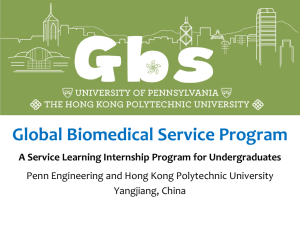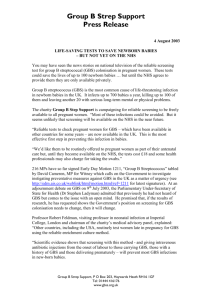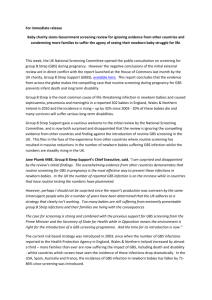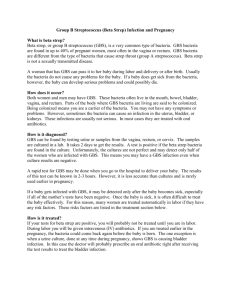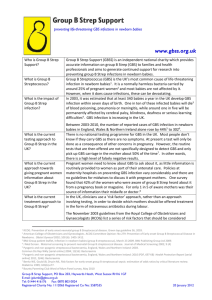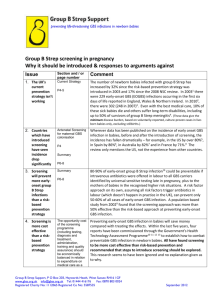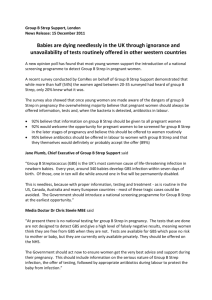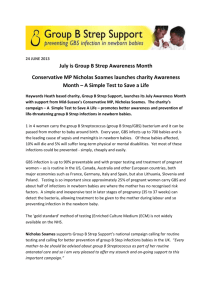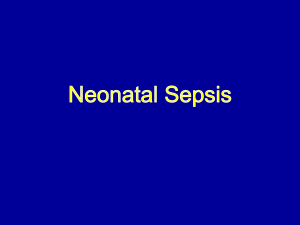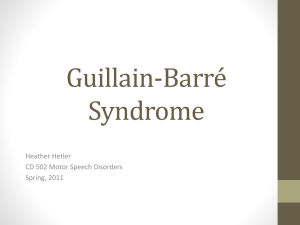Group B Strep in pregnancy & newborn babies
advertisement
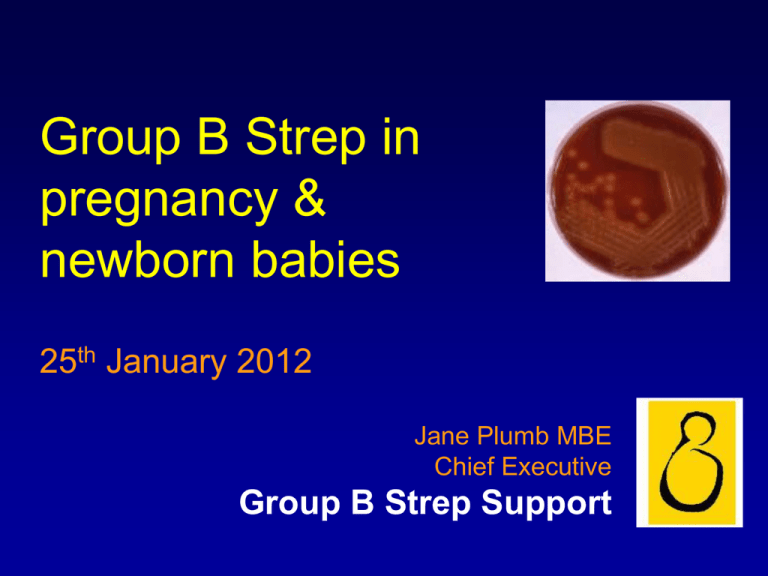
Group B Strep in pregnancy & newborn babies 25th January 2012 Jane Plumb MBE Chief Executive Group B Strep Support GBSS Medical Advisory Panel Prof Philip Steer (Chair) Dr Alison Bedford Russell Emeritus professor at Imperial College & consultant obstetrician at the Chelsea and Westminster Hospital, London Neonatal Consultant, Birmingham Women's Clinical Lead, South West Midlands Newborn Network & Hon Associate Clinical Professor, Warwick Medical School Dr Christine McCartney OBE, Executive Director, Health Protection Agency’s Microbiology Services, London Philippa Cox Consultant Midwife, Supervisor of Midwives, Homerton Hospital, London Streptococci Classified into Lancefield groups (1938) • Group A Streptococcus S. pyogenes – necrotising fasciitis – toxic shock syndrome – 1574 cases in England, Wales & NI (2010) • Group B Streptococcus • S. agalactiae – Wound infections & septicaemia in adults – 1610 cases in England, Wales & NI (2010) What does group B Strep do? • Colonisation – Asymptomatic and intermittent – Intestinal (<30% of adults) – Vaginal (<25% of women) • Infection – Newborn babies – Adults: the elderly, pregnant/postpartum women, others with underlying disease Age-specific rates of group B Strep bacteraemia reports: England, Wales & Northern Ireland, 2010 Source: Health Protection Report Vol. 5 No. 46 – 18 November 2011 Group B Strep infection • “Early onset” 0-6 days (~75% cases) – – – – 90% show within 12 hours Usually septicaemia and pneumonia 11% mortality, 7% morbidity 90% preventable IV Penicillin • “Late onset” 7-90 days (~25% cases) – – – – Usually meningitis and septicaemia 8% mortality, 21% morbidity (up to 50% with meningitis) No current prevention: good hygiene/education Vaccine: future hope for both late & early onset Neonatal GBS disease in the UK – age at onset Source: Heath PT, Balfour G, Weisner AM, Efstratiou A, Lamagni TL, Tighe H et al. Group B streptococcal disease in UK and Irish infants younger than 90 days. Lancet 2004; 363(9405):292-294. EOGBS Infection Incidence per 1,000 live births • 0.41 culture proven cases – Cultures growing GBS from blood & CSF – Voluntarily reported to Health Protection Agency for England, Wales & NI 2010 • 3.6 proven plus probable cases – Sick babies with cultures growing GBS from nonsterile sites (S Luck, Lancet 2003) • Plus stillborn babies > 3.6/1,000 Known risk factors for EOGBS infection • • • • • • Previous GBS baby GBS bacteriuria current pregnancy GBS found current pregnancy Maternal intrapartum fever (>380C) PROM >18 hours before birth Preterm labour 10 x 4x 3x 3x 3x 3x Reducing EOGBS risk • Intrapartum antibiotic prophylaxis – Only proven effective method of prevention available – 90% prevention • Intramuscular antibiotics pre-labour – May eradicate GBS colonisation for up to 6 weeks – Small studies & no GBS infection in control or treated group • Vaginal flushing with Chlorhexidine – No evidence it reduces EOGBS infection • Oral Antibiotics – No evidence it reduces EOGBS infection (treats GBS UTI) UK Guidelines • Royal College of Obstetricians & Gynaecologists 2003 Guideline (update 2012) – Antibiotics in labour for women with recognised risk factors, including carriage – 2007 audit – few units comply fully • UK National Screening Committee (review 2012) – Screening not recommended: “clinical and cost effectiveness uncertain” • RCT trial proposed (2007 £11.3M) but not funded • Trial now ethical ? • Consultation Spring 2012 - do comment England, Wales & NI Cultureproven EOGBS infection 2003-10 Introduction of RCOG Guidelines Source: Health Protection Agency USA - Incidence of early- and late-onset invasive group B Strep disease — Active Bacterial Core surveillance areas, 1990–2008 Prevention of Perinatal Group B Streptococcal Disease Revised Guidelines from CDC, 2010 and adapted from Jordan HT, et al. Revisiting the need for vaccine prevention of late-onset neonatal group B streptococcal disease. Pediatr Infect Dis J 2008;27:1057–64. Countries routinely screening pregnant women for GBS Australia Argentina Belgium Canada Czech Republic France Germany Hong Kong Italy Kenya Poland Spain Slovenia Switzerland USA Reduction of EOGBS incidence in other countries • • • • Australia 82% Spain 86% France 71% USA 86% (Daley et al, 2004) (Andreu et al, 2003) (Albouy-Llaty et al, 2011) (Jordan et al, 2008) Known risk factors for EOGBS infection • Previous GBS baby • GBS bacteriuria current pregnancy 10 x • GBS found current pregnancy • Maternal intrapartum fever (>380C) • PROM >18 hours before birth • Preterm labour 4x 3x 3x 3x 3x 40% of EOGBS babies have no risk factors Without routine testing mums, these aren’t identified as being at risk - not preventable without testing “Gold Standard” test for GBS carriage • When? – 35-37 weeks of pregnancy • Where & who? – Low vagina & anorectal swab/s (no speculum) – Health care professional or pregnant woman • What culture method? – Enriched Culture Medium (ECM) - 24-48 hours to grow HPA BSOP58 Processing Swabs for GBS carriage What GBS tests for carriage are available in the UK? • NHS: not routine but if offered, usually: – High vaginal swab, sometimes using speculum – Direct agar plating (misses up to 50% of carriers) • Privately + a few NHS trusts: – Low vaginal & rectal swab(s) – Enriched Culture Medium (very predictive for 1-5 weeks) • Private PCR: – Low vaginal & rectal swab(s) – Potentially intrapartum (some less than 2 hours) – Not validated for use in the UK (though approved by FDA & Health Canada & bears CE mark for Europe) BMJ 2007. Preventive strategies for group B streptococcal & other bacterial infections in early infancy: cost effectiveness & value of information analyses. (Colbourn et al) • Current best practice (treating only high risk women) not cost effective • Adding culture testing for low risk term women & treating all preterm & high risk women would be the most cost effective option Health Technology Assessment 2009. Rapid testing for group B Streptococcus during labour: a test accuracy study with evaluation of acceptability & cost-effectiveness. (Daniels et al) • Routine intrapartum antimicrobial prophylaxis to all women without screening most cost effective (rejected). • After this, culture based screening at 35– 37 weeks’, with antibiotics to all women screen positive most cost effective (assuming all women in premature labour receive intrapartum antimicrobial prophylaxis) BJOG 2010. Cost-effectiveness of rapid tests & other existing strategies for screening and management of EOGBS during labour. (Kaambwa et al) • Routine intrapartum antimicrobial prophylaxis to all women without screening most cost effective strategy (rejected). • Next, intrapartum antibiotic prophylaxis directed by screening with enriched culture cost-effective. Risk-factor-based screening is not cost-effective compared with screening based on culture. Bounty Survey – May 2010 • Bounty’s Word of Mum™ omnibus surveys are run bi-monthly from January until November. • Word of Mum™ omnibus survey carried out between the 19th and 31st May 2010 • 2,226 interviews with women from the early stages of pregnancy those with a youngest child aged 2 years. Group B Strep awareness Aware of Group B Strep How/ where heard about GBS Base: All respondents (2,226) Base: All who are aware of GBS (1,277) Nearly 3 in 5 mums/ mums-to-be are aware of GBS. The majority first heard about GBS from a non-HCP source – 42% from a pregnancy book or magazine and 21% from a friend or other mum. Only 20% of those aware of GBS found out about it from a midwife. Group B Strep testing Base: All respondents (2,226) Yes No All women should be informed about GBS by GP/ midwife during pregnancy 95% 5% Reliable test should be offered on NHS to all pregnant women 94% 6% Would have/ would have had test if it had been offered 94% 6% All pregnant women should be told about option to have private test costing £32 94% 6% The is widespread though amongst mums that they should be made more aware of GBS testing – from awareness in pregnancy through to being offered a test on the NHS or the option to pay for one. 56% would pay to have the private test. A quarter would like to have the test but couldn’t afford to pay for it. What happens after delivery? • Mums of most babies identified as at risk will receive 4+ hours antibiotics in labour to prevent EOGBS infection • Those who don’t? • No clear guidance • 90% EOGBS <12 hours Babies born at increased risk Mum has had less than 2 hours IAP: • Examined thoroughly & investigated by a Paediatrician as appropriate • Observed for at least 12 hours (ideally 24) Mum has had more than 2 hours IAP: • Carefully assessed by appropriately trained Paediatrician or ANNP • Monitoring (12-24 hours) for those at highest risk No antibiotics for baby if completely healthy – if any doubt, antibiotics until infection ruled out Typical signs of early-onset GBS infection • • • • • • • • • grunting; lethargy; irritability; poor feeding; very high or low heart rate; low blood pressure; low blood sugar; abnormal (high or low) temperature; and abnormal (fast or slow) breathing rates with blueness of the skin due to lack of oxygen (cyanosis). Typical signs of late onset GBS infection • • • • • • • • • • • • • • • fever; poor feeding and/or vomiting; impaired consciousness; fever, which may include the hands and feet feeling cold, and/or diarrhoea; refusing feeds or vomiting; shrill or moaning cry or whimpering; dislike of being handled, fretful; tense or bulging fontanelle (soft spot on the head); involuntary body stiffening or jerking movements; floppy body; blank, staring or trance-like expression; abnormally drowsy, difficult to wake or withdrawn; altered breathing patterns; turns away from bright lights; and pale and/or blotchy skin. Topical issues Reinfection risk 1-3% Multiple Births: • IV antibiotics to other baby/babies if one infected. GBS carriers breastfeeding: • Recommended antibiotics safe for breastfeeding • Advantages of breastfeeding outweigh remote risk of transmitting GBS Hand washing: • Everyone should before handling a baby 0-3 months. www.gbss.org.uk Key facts GBSS Stand 12 • Approx 25% of women carry GBS • 1 : 300 babies develop EOGBS born GBS carriers (no IAP) • 1 : 6000 babies develop EOGBS born GBS carriers (with IAP) • 40% of EOGBS babies have no known risk factors (unknown maternal carriage) http://www.gbss.org.uk/epetition seeking better prevention of EOGBS infection

